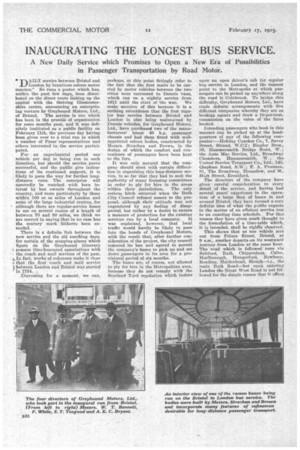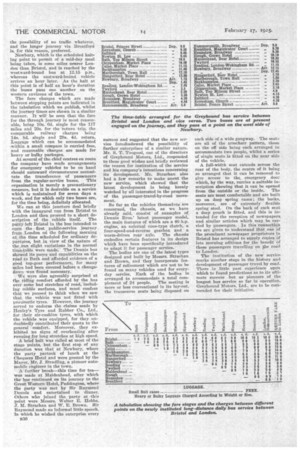INAUGURATING THE LONGEST BUS SERVICE.
Page 12

Page 14

If you've noticed an error in this article please click here to report it so we can fix it.
A New Daily Service which Promises to Open a New Era of Possibilities in Passenger Transportation by Road Motor.
AILY service between Bristol and .LJLondon by luxurious saloon motor coaches." So runs a poster which has, within the past few days, been distributed on the direct route linking up the capital with the thriving Gloucestershire centre, announcing an enterprising venture by Greyhound Motors, Ltd., of Bristol. The service is one which has been in the process of organization for some months past, and it was definitely instituted as a public facility on February 11th, the previous day having been given over to a trial run in which a number of Press representatives and others interested in the service participated.
For an experimental period one vehicle per day is being run in each direction, but should the service prove Successful, and the public give indications of its continued support, it is likely to pave the way for further longdistance runs. The enterprise will assuredly he watched with keen interest by bus owners throughout the country, and more particularly by those within 100 or so miles of London and some of the large industrial centres, for although there are regular-service buses in use on several routes of a length of between 70 and 80 miles, we think we are correct in saying that in no case has the century mark hitherto been exceeded.
There is a definite link between the new service and the old coaching days, for certain of the stopping-places which figure on the Greyhound itinerary • possess time-honoured associations with • the coach and mail services of the past.
In fact, works of reference make it clear r that the first coach and mail service 5 between London and Bristol was started
in 1784.
Digressing for a moment, we can, perhaps, at this point fittingly refer to the fact that the first mails to be carried by motor vehicles between the two cities were entrusted to Dennis vans, which ran on a nightly service from 1911 until the start of the war. We make mention of this because it is a. striking coincidence that the first regular bus service between Bristol and London is also being maintained by Dennis vehicles, for Greyhound Motors, Ltd., have purchased two of the manufacturers' latest 40 h.p. passenger chassis and had them fitted with wellappointed saloon bodies, constructed by Messrs. Strachan and Brown, in the design of which the comfort and convenience of passengers have been kept to the fore.
It was only natural that the company should meet with certain difficulties in organizing this long-distance service, in so far that they had to seek the authority of many licensing committees in order to ply for hire in the areas within their jurisdiction. The only serious hitch occurred when the Bath City Council refused assent to the proposal, although their attitude was not engendered by any feeling of disapproval, but rather by a desire to ensure a measure of protection for the existing services run by a local company. It was explained, however, that local traffic would hardly be likely to pass into the had of Greyhound Motors, with the result that, after further consideration of the project, the city council removed its ban and agreed to permit the company's buses to pick up and set down passengers in its area for a provisional period of six months.
The buses are, of course, not allowed to ply for hire in the Metropolitan area, because they do not comply with the Scotland Yard regulation which insists upon an open driver's cab for regular bus service in London, and the nearest point to the Metropolis at which passengers can be picked up anywhere along the road is Colnbrook. TO bridge this difficulty, Greyhound Motors, Ltd., have made definite arrangements with five different companies whereby they act as booking agents and draw a 10-per-cent. commission on the value of the fares booked.
Intending passengers who book in this manner can be picked up at the headquarters of any of the following companies :—Holiday Coaches Co., 7, Savoy Street, Strand, W.C.2; Bingley Bros., 19, Hammersmith Bridge Road, W.; the Auto Mac Service, Ltd., Broadway Chambers, Hammersmith, W.; the United Service Transport Co., Ltd.. 143, Cslapham Road, S.W.; F. A. Freeman, 81, The Broadway, Hounslow, and 9, High Street, Brentferd.
The directors of the company have given careful eonsideration to every detail of the service, and having had several years' experience in the operation of a large fleet of buses in and around Bristol, they have formed a very definite idea of what the public expects in the matter of an efficient service run to an exacting time schedule. For this reason they have given much thought to the formulation of a time-table which, it is intended, shall be rigidly observed.
This shows that as one vehicle sets nut from Prince Street, Bristol, at 9 a.m., another departs on its westward journey from London at the SatEIC hour. The road which is followed runs via Saltford, Bath. Chippenham, Caine, Marlborough, Hungerford, Newbury, Reading, Maidenhead, Slough—i.e., the main Bath Road—but upon entering London the Great West Road is not fol. lowed for the simple reason that it offers the possibility of no traffic whatever, and the longer journey via Brentford is, for this reason, preferred. Newbury, which is the scheduled halting point to permit of a mid-day meal being taken, is some miles nearer London than Bristol, and is reached by the westward-bound bus at 12.15 pm., whereas the eastward-bound vehicle arrives an hour later. As the halt at this point is of half an hour's duration the buses pass one another on the western environs of the town. The fare charges which .are made between stopping points are indicated in the tabulation which we publish, whilst the journey times are shown in a similar manner. It will be seen that the fare for the through journey is most reasonable, being 10s. ed. single for the 117 miles and 20s. for the -return trip, the comparable railway charges being 14s. Sd. single and 20s. 4d. return. Luggage which can be accommodated .within a small compa.gs is carried free, and reasonable charges are made for heavy or bulky packages. At several of the chief centres en route the company have made arrangements for emergency vehicles to be on hand should untoward circumstances necessitate the transference of passengers from the regular-service buses. This organization is merely a precautionary measure, but it is desirable on a service which is maintained for seven days a week, and for which only two buses are, for the time being, definitely allocated.
We can at this juncture deal briefly with the inaugural run from Bristol to London and then proceed to a short de
scription of the vehicle itself. The party left Bristol in the bus intended to open the first public-service journey from London cal the following morning at the time scheduled for ordinary departures, but in view of the nature of the ,run slight variations in the normal time-table were made. The Dennis bus showed its paces and capabilities on the road to Bath and afforded evidence of a good top-gear performance, for many miles had been covered before a changedown was found necessary. We were also agreeably surprised at the riding comfort afforded by the bus over some bad stretches of road, including cobble surfaces, and must confess that we paused to think when we saw that the vehicle was not fitted with pneumatic tyres. However, the journey served to endorse the claims made by Henley's Tyre and Rubber Co, Ltd., for their air-cushion tyres, with which the vehicle was equipped, for they undoubtedly contributed their quota to tha general comfort. Moreover, they exhibited no signs of overheating after running for long stretches at high speed. A brief halt was called at most of the stage points, but the first stop of any duration was that at Newbury, where the party partook of lunch at the Chequers Hotel and were greeted by the Mayor, Mr. Stradling, a pioneer automobile engineer in the town.
• A further break-this time for teawas made at Maidenhead, after which the bus continued on its journey to the Great Western Hotel, Paddington, where the party was met by Sir Raymond Dennis and entertained to dinner. Others who joined the party at this point were Messrs. Walter E. Hobbs, .T. M. Strachan and W. E. Brown. Sir Raymond made an informal little speech, In which he wished the enterprise every B30 success and suggested that the new service foreshadowed the possibility of further enterprises of a similar nature. Mr. S. T. Toogood, one of the directors of Greyhound Motors, Ltd., responded to these good wishes and briefly reviewed the reason for institution of the service and his company's intentions concerning its development. Mr. Strachan also had a few remarks to make anent the new service, which showed that the latest development is being keenly watched by all interested in the progress of the passenger-travel-by-road movement. So far as the vehicles themselves are concerned, the chassis, as we have already said, consist of examples of Dennis Bros.' latest passenger model, the main features of which are a 40 h.p. engine, an external cone-type clutch, a four-speed-and-reverse gearbox and a worm-driven rear axle. The chassis embodies certain features in its design which have been specifically introduced to adapt it for passenger service. The bodies are one of the latest types designed and built by Messrs. Strachan and Brown, and they incorporate features of refinement which are not to be found on many vehicles used for everyday service. Each of the bodies is arranged to accommodate a total complement of 24 people. The seating is more or less conventional in its lay-out. the transverse seats being disposed on each side of a wide gangway. The seat2 are all of the armchair pattern, those on the off side being each arranged to accommodate two people, whilst a series of single seats is fitted on the near aide of the vehicle. A full-width seat extends across the rear of the body, the centre of it being so arranged that it can be removed to give access to the emergency door which, by the way, carries a suitable inscription showing that it can be opened from the outside or the inside. The seats are most comfortable and are built up on deep spring cases; the backs, moreover, are . of extremely flexible spring steel. On the back of each seat a deep pouch is fitted, and this is intended for the reception of newspapers and similar articles which may, be carried by passengers. In this t. onnectiOn we are given to understand that one of the prominent newspaper proprietors in Bristol has arranged to supply copies of late morning editions for .the benefit of those passengers travelling on pie road to London. The institution of the new service marks another stage in the history and development of passenger travel by road. There is little past experience upon which to found predictions as to its ultimate success but as pioneers of the longest bus service so far in operation. Greyhound Motors. Ltd.. are to be commended for their initiative.
































